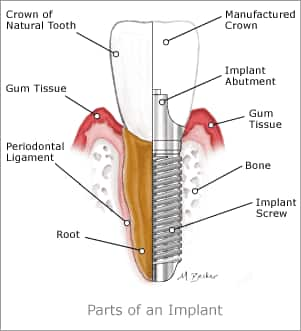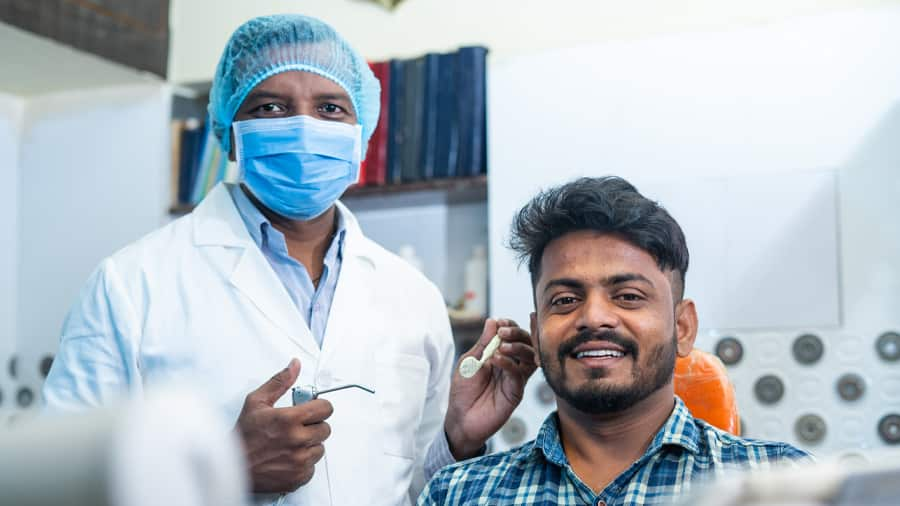
Implants are devices that replace the roots of missing teeth. They are used to support crowns, bridges or dentures. Implants are surgically placed in your jawbone. Most of the time, implants feel more natural and secure than other methods of replacing missing teeth, such as dentures.

There are many reasons it's important to replace missing teeth:
There are several types of implants, including:
- Root form
- Subperiosteal
- Mini
Root-form implants are the most common type used today. A root-form implant is made of titanium. It looks like a small cylinder or screw. After an implant is placed in the jawbone, a metal cylinder called an abutment eventually is attached to it. The abutment serves as a base for a crown, denture or bridge.
The key to the success of all implants is a process called osseointegration. This is how the bone in the jaw grows into and around the implant. Titanium is a special material that the jawbone accepts as part of the body.
The ability of titanium to fuse with bone was discovered by accident. In 1952, a scientist named Per-Ingvar Brånemark was using titanium chambers screwed into bones as part of his research. He was trying to learn about how bone healed after an injury. When he tried to remove the titanium chambers, he found they had become integrated with the bone.
Dr. Brånemark then did further research into how titanium implants might work. In 1965, the first root-form implants were placed in people. Other types of implants also have been used for the last 30 to 40 years. Many implant systems are available from various dental manufacturers.
Success
Studies indicate that surgical placement of root-form implants is successful more than 90% of the time. When these implants fail, the problems usually occur within the first year after surgery. After that, only about 1% of all implants fail each year.
Implants have become increasingly popular since the American Dental Association (ADA) endorsed them in 1986. Between 1986 and 1999, the number of implant procedures tripled.
It is now estimated that more than half a million implants are placed every year in the United States.
Implants vs. Alternatives
Depending on your particular problem, implants can be more expensive than the alternatives (denture or bridge). A basic implant plus a crown can cost between $2,000 and $5,000. The fees will depend on many factors and vary considerably. A few insurance companies cover implants, but may have low annual dollar limits. You should always check with your insurer.
The upfront cost for implants can be more than for other types of restorations. But the investment can pay off in the long run. You may not need an implant for every missing tooth. Your dentist can discuss how many implants you will need.
Other benefits of implants include:
Feel — Because implants are embedded in your bone, they feel more like your natural teeth than dentures.
Convenience — You will not need to worry about denture adhesives or having your dentures slip, click or fall out when you speak.
Nutrition — You may be able to chew better with implants. Chewing can be difficult with regular dentures, especially ones that don't fit perfectly. A regular upper denture also covers your palate, which can reduce your sense of taste.
Self-esteem —Because implants are so much like your natural teeth, you will think about them less. Your self-esteem and confidence will be improved because you will not have to worry about denture problems or people noticing that you have missing teeth. Regular dentures also can affect your speech. This can make you less self-confident when talking.
4/9/13
© 2002- 2018 Aetna, Inc. All rights reserved.
This article is intended to promote understanding of and knowledge about general oral health topics. It is not intended to be a substitute for professional advice, diagnosis or treatment. Always seek the advice of your dentist or other qualified healthcare provider with any questions you may have regarding a medical condition or treatment.
ORAL HEALTH QUIZ
What's behind your smile?
Take our Oral Health assessment to get the most from your oral care routine
ORAL HEALTH QUIZ
What's behind your smile?
Take our Oral Health assessment to get the most from your oral care routine













